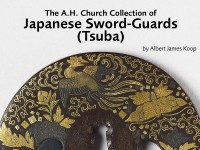The A. H. Church Collection of Japanese Sword-Guards (Tsuba)
An unpublished catalogue of the A. H. Church collection of Japanese sword-guards (tsuba) by Albert James Koop.

The founder, Kitagawa Sōteen I (also called Shūten and possibly Sōheishi Niūdō), flourished about 1650 and, like his successors, worked at Hikone, whence the name Hikone-bori for the style they evolved. The signature of his son, Sōten II (Sōheishi Niūdō), is that most frequently found on guards of this school, but it has been more extensively forged, perhaps, than that of any other maker. The demand for Hikone-bori, indeed, grew to enormous proportions and there was a wholesale manufacture of bad imitations in the Aidzu district of Mutsu province during the early years of the 19th century.
The Sōten style may be summed up as the marubori-zōgan with the addition of elaborate landscape details. The figures, whether large or small, are either modelled completely in the round, the ground being more or less cut away and the whole enclosed by a border; or else they are in high relief on a solid ground. The work is nearly always in iron, with the nude portions encrusted in silver or copper, the patterns of the garments and the minute botanical details of the landscape being richly overlaid with gold.
The favourite subjects are taken from Chinese history and legend, or represent Japanese battle-scenes, especially from the Gempei campaigns of the 12th century and the Korean expeditions of the Empress Jingō and the Taikō Hideyoshi.
N.B. – Unless the contrary is stated, Hikone-bori, i.e. openwork modelling almost completely in the round, with various details (faces, hands, etc.) in iroye incrustation, within slender border, is to be understood in all these descriptions.
 Round tsuba depicting Kanzan and Jittoku standing next to bamboo plants (EAX.10783)
Round tsuba depicting Kanzan and Jittoku standing next to bamboo plants (EAX.10783)
 Mokkō-shaped tsuba with a dragon emerging from waves (EAX.10784)
Mokkō-shaped tsuba with a dragon emerging from waves (EAX.10784)
 Tsuba with egrets, men in boats, and a water wheel (EAX.10785)
Tsuba with egrets, men in boats, and a water wheel (EAX.10785)
Notice
Object information may not accurately reflect the actual contents of the original publication, since our online objects contain current information held in our collections database. Click on 'buy this publication' to purchase printed versions of our online publications, where available, or contact the Jameel Study Centre to arrange access to books on our collections that are now out of print.
© 2013 University of Oxford - Ashmolean Museum





